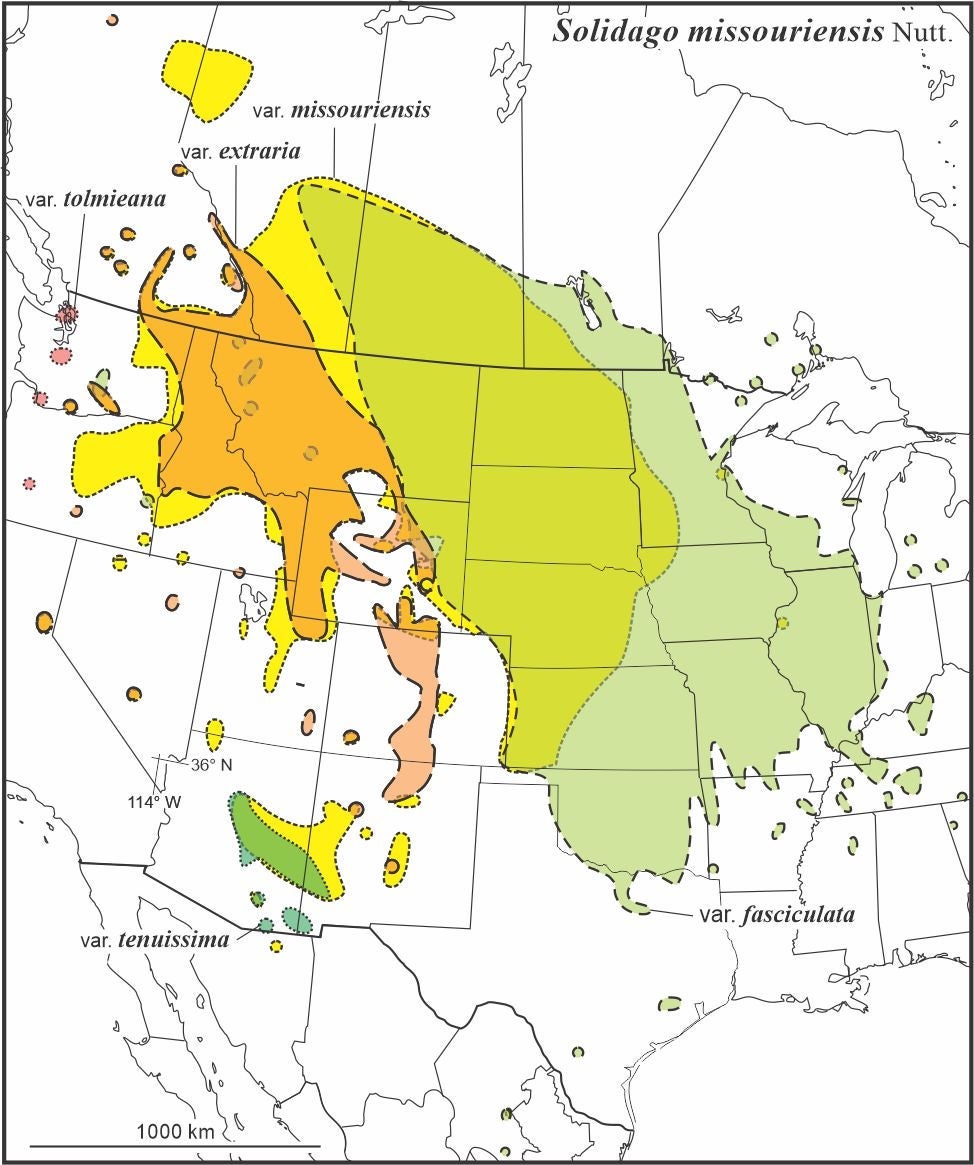Missouri Goldenrod
Solidago missouriensis Nutt. is native to the prairies and Rocky Mts of central and western North America. Stems develop from elongated creeping rhizomes and the proximal and mid stem leaves are often 3-nerved (Semple and Cook 2006 FNA). Plants on eastern wet prairies can be 50-80 cm tall, but further west plants are usually much shorter. Several varieties have been described, but were not treated in FNA. The species includes diploids (2n=18) and tetraploids (2n=36) with the latter occurring near or in the mountains (Semple and Chmielewski 2021).
Cronquist (1955) recognized 4 varieties that were present in the Pacific Northwest, but did not recognize them later (Cronquist 1994) stating that they graded into each other where the ranges overlapped making distinguishing them too difficult. Varieties were discussed in Semple and Cook 2006 but not presented in detail. Semple & Chmielewski (2021) determined that although the varieties could be difficult to distinguish there was some value in recognizing them and presented a key to separate them.
Key to the varieties of Solidago missouriensis (some individuals of all varieties can be difficult to distinguish from var. missouriensis)
1. Plants tending to be tall and rather leafy stemmed often with multiple narrow acute leaves in upper stem nodal clusters, usually 4-9 dm; inflorescence evidently secund, Great Plains and prairie-like habitats further east, occasionally to Grand Coulee, Washington
................................ var. fasciculata
1. Plants generally shorter seldom > 5 dm, lower leaves gen persistent, middle and upper ones relatively few with limited lateral branch leaves present in mid to upper nodes of main stem
2. Heads relatively large (4-5 mm), somewhat secund inflorescence; rare on prairies W of Cascades Mts.
................................ var. tolmieana
2. Plants E of the Cascade Mt. with either non-secund inflorescences or involucres smaller
3. Heads relatively large, involucres usually 4-5 mm; inflorescence seldom at all secund, mountains
.................................. var. extraria
3. Heads generally smaller, the involuvcres 3-4 mm (rarely more), inflorescences secund, branches sometimes broadly ascending to spreading.
4. Lower leaves linear-lanceolate, petioles sometimes longer than blades; Mogollon Rim and Sky Island mountains of Arizona and SW New Mexico
................................... var. tenuissima
4. Lower leaves lanceolate; western prairies near mountains and in mountains from Alberta to New Mexico and Arizona
.................................. var. missouriensis
Cronquist, A. 1955. Solidago. pp. 303-311. Vascular plants of the Pacific Northwest. Part 5: Compositae. University of Washington Press. Seattle.
Cronquist, A. 1994. Intermountain flora; vascular plants of the Intermountain West, U.S.A. Vol. 5. Asterales. New York Botanical Garden. New York.
Semple, J.C., and J.G. Chmielewski. 2021. Cytogeography of Solidago missouriensis (Asteraceae: Astereae) and observations on varieties. Phytoneuron 2021-49. 1-15.
Last revised 19 May 2025 by J.C. Semple
© 2025 J.C. Semple, including all photographs unless otherwise indicated.
1-6. Solidago missouriensis. 1. var. missouriensis, Crook Co., Wyoming. 2-3. var. extraria. Semple & Brammall 2710, Jefferson Co., Colorado and Semple et al 9280, Elko Co., Nevada. 3. var. fasciculata, Semple 11849, Sherburne Co., Minnesota. 4. var. tenuissima, Semple & Chmielewski 9020, Gila Co., Arizona. 6. Range map.











